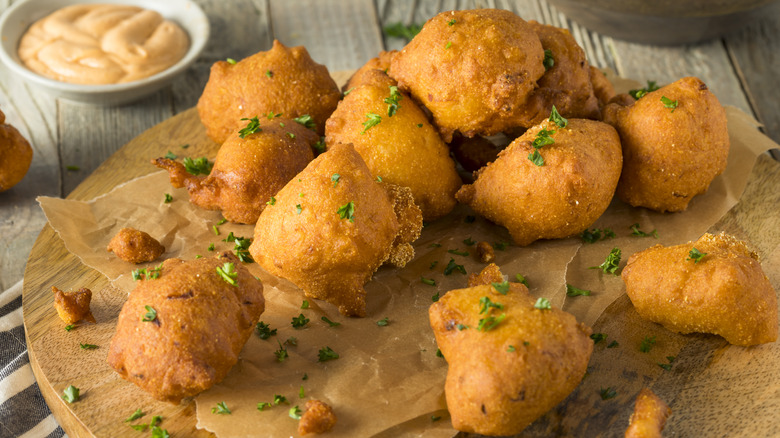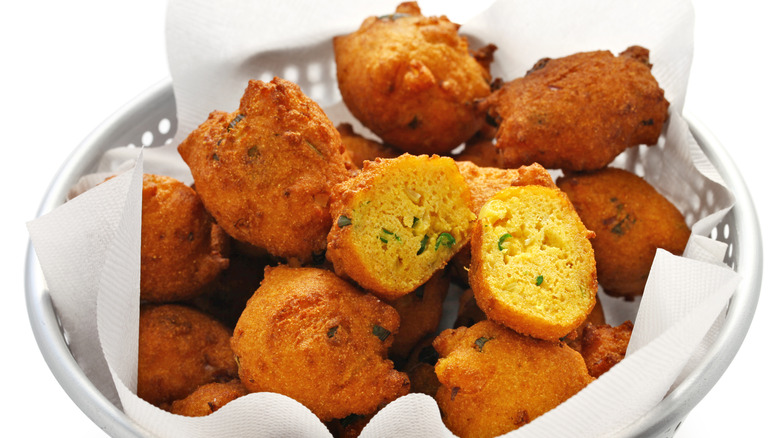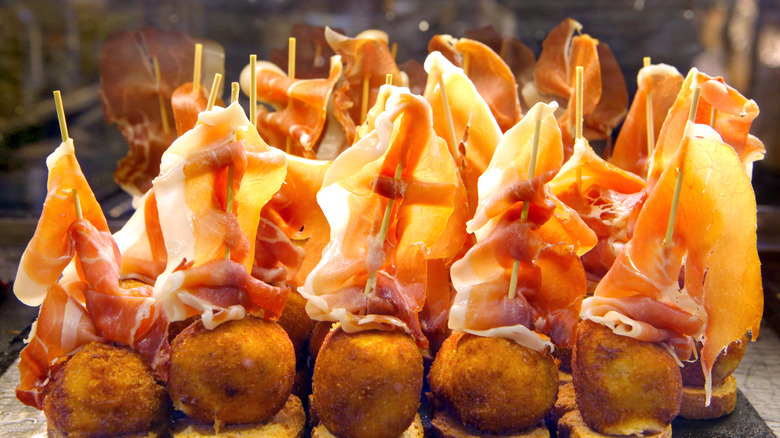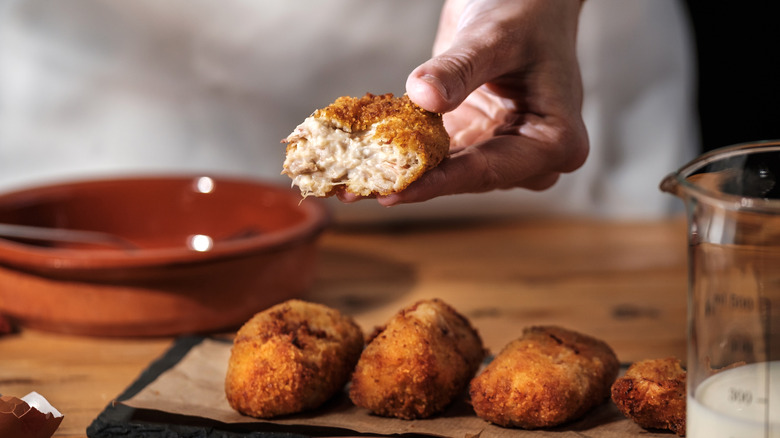Croquettes Vs. Hushpuppies: What's The Difference?
In the land of fried foods, there are type types of appetizers that seem similar but have very different stories. Hushpuppies and croquettes have a similar textures and cooking techniques, but their origins, ingredients, and flavor profiles differ. While croquettes have roots in European cooking and from techniques used to take food scraps and turn them into delicious eats, hushpuppies came from the American South as a way to use fish fry batter to create a unique side dish. Both recipes are born from a cook's inventive curiosity and we're downright thankful. Let's dig in!
A few notes first: It should be noted that the purpose of this article we're comparing Spanish croquettes de Jamón with hushpuppies and those croquettes are not to be confused with French croquettes which are potato-based, and they are also delicious. But back to hushpuppies and croquettes de Jamón.
Hushpuppy History
Hushpuppies are said to have originated in the American South and while the hushpuppy's origins are actually disputed, there is enough information out there to understand what makes them unique from Spanish croquettes.
There is plenty of lore surrounding the hushpuppy. Some believe the name came from soldiers during the Civil War using these fried treats as a way to keep dogs quiet and not give away their location. Other legends say that the fried treat may have started out as a dish of battered and fried salamanders (referred to then as water puppies.)
Serious Eats notes that these stories are likely legends and that the true original recipe for hushpuppies may have come from a formerly enslaved man by the name of Romeo Govan. Govan was famous for hosting fish fries that included frying redfish and red horsefish. He would fry bits of left-over batter and call it Red Horse Bread. This food later may have been referred to colloquially as hushpuppies, with that name sticking.
Spanish Croquettes Story
Funny enough croquettes have a disputed history story as well. According to the Spanish Food Guide, there are three origin stories that are traced back to France. One story claims that Louix XIV's cook wrote about having made croquettes in 1691. Another account claims that a French chef named Antonin Carême serve the dish at a royal banquet in 1817. A third story says that two French chefs created the recipe in 1898. No matter who got to them first croquettes were created as a way to give new life to food scraps, particularly meat, per Food Lover Tour.
Croquettes are made by mixing a bechamel sauce with meat scraps and allowing it to cool and congeal before making little balls or ovals battering and frying them. Croquettes de Jamón are a popular tapas item and a staple in many Spanish kitchens, according to Food Lover Tour and while they're most often made with ham, they can also be made with chicken, codfish, cheese, octopus, or mushrooms. Just keep in mind that the bechamel base means they are not gluten-free.
Which is which?
While both hushpuppies and Spanish croquettes are made from a batter that is deep fried, there are a few distinct differences between them.
Hushpuppies generally don't contain meat while Spanish croquettes are traditionally made with ham. Croquettes are also made from a batter that contains flour, while hushpuppies are traditionally made from a cornmeal-based batter and are therefore gluten-free.
Croquettes are made by mixing meat and or vegetables with a bechamel sauce but are then cooled, formed, battered, and then fried. Hushpuppies are made simply by deep frying spoonfuls of cornmeal batter, so there are fewer steps involved when making hushpuppies and they can be made much faster. According to this hushpuppy recipe, hushpuppies' average prep time is 10 minutes, and their average cook time is just six minutes. The Spruce Eats notes that the average prep time for Spanish croquettes is 35 minutes and the average cook time is 32 minutes.
Whether you're partial to one over the other, or an equal opportunity fan, both of these delicious foods can satisfy the craving for a fried food delight. And if you're the kind of person who loves fried foods but feels a bit mystified by the process don't miss these common mistakes that everyone makes when frying food!



